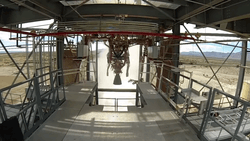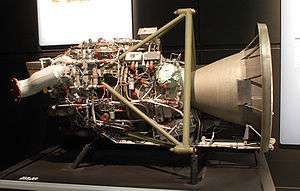BE-3
 | |
| Country of origin | United States |
|---|---|
| Manufacturer | Blue Origin |
| Status |
BE-3 Completed development; first flight test in 2015. BE-3U in testing. |
| Liquid-fuel engine | |
| Propellant | Liquid oxygen / liquid hydrogen |
| Cycle |
BE-3: Combustion tap-off BE-3U: Expander cycle |
| Performance | |
| Thrust (vac.) | BE-3U: 670 kN (150,000 lbf) |
| Thrust (SL) | BE-3: 490 kN (110,000 lbf) |
| Used in | |
|
BE-3: New Shepard suborbital vehicle BE-3U: New Glenn orbital launch vehicle (second and third stage) | |
The BE-3 (Blue Engine 3) is a LH2/LOX rocket engine developed by Blue Origin.[1]
The engine began development in the early 2010s, and completed acceptance testing in early 2015. The engine is being used on the Blue Origin New Shepard suborbital rocket, for which test flights began in 2015.[2] The engine was under consideration by United Launch Alliance (ULA) for use in a new second stage, the Advanced Cryogenic Evolved Stage, in ULA's Vulcan orbital launch vehicle with first flight in the 2020s.[3][4]
History
The BE-3 follows the earliest rocket engine development efforts at Blue Origin in the 2000s. Blue's first engine was a "simple, single-propellant engine" called the Blue Engine-1 (BE-1) which used peroxide propellant and generated only 8.9 kN (2,000 lbf) of thrust, and their second, the Blue Engine-2 (BE-2) which was a bipropellant engine using kerosene and peroxide, producing 140 kN (31,000 lbf) thrust.[5]
In January 2013, the company announced the development of the Blue Engine-3 BE-3, a new liquid hydrogen/liquid oxygen (LH2/LOX) cryogenic engine. The engine was originally announced to produce 440 kN (100,000 lbf) thrust, with initial thrust chamber tests planned for mid-February 2013 at NASA Stennis.[6] The thrust chamber tests were run sometime in 2013.[7]
The BE-3 was successfully tested in late 2013 on a full-duration simulated suborbital burn, with coast phases and engine relights, "demonstrating deep throttle, full power, long-duration and reliable restart all in a single-test sequence."[8] NASA has released a video of the test.[7]
By December 2013, Blue Origin updated engine specifications following engine tests conducted on test stands at ground level, near sea level. This demonstrated that the engine could produce 490 kilonewtons (110,000 lbf) of thrust at full power, and could successfully throttle down to as low as 110 kilonewtons (25,000 lbf) for use in controlled vertical landings if needed for that purpose on particular launch vehicles.[8] The final engine specifications, released in April 2015 following the full test phase, included a minimum thrust of 89 kilonewtons (20,000 lbf), an even wider throttling capability by 20 percent than the preliminary numbers, while maintaining the previously released full power thrust spec.[9]
As of December 2013, the engine had "demonstrated more than 160 starts and 9,100 seconds (152 min) of operation at Blue Origin's test facility near Van Horn, Texas."[8][10] Additional testing of the BE-3 was completed in 2014, with the engine "simulating a sub-scale booster suborbital mission duty cycle."[11] Test stand testing of the engine was completed by April 2015, with over 450 engine firings and a cumulative engine test time of over 500 minutes. Blue Origin stated it would make the first test flight of its New Shepard vehicle later in 2015.[9]
In the event, Blue made the first flight test of the engine on the New Shepard suborbital vehicle before the month was out, flying a boost profile to 93,500 meters (307,000 ft) altitude on 29 April 2015.[12]
As of April 2015, United Launch Alliance (ULA) is considering the BE-3 for use in a new second stage, the Advanced Cryogenic Evolved Stage (ACES), which is, as of April 2015, planned to become the primary upper stage for ULA's Vulcan orbital launch vehicle in the 2020s. The Vulcan is planned to begin orbital flights in 2019 with an existing Centaur upper stage, and is considering three engines from various manufacturers for the ACES stage which would putatively begin flight in 2023, with selection expected before 2019.[3]
While development of a sea-level version of the engine was completed and fully qualified by early 2015, Blue said then that they intend to develop a vacuum version of the engine to operate in space.[13]
In January 2016, the US Air Force provided partial development funding to Orbital ATK to develop an extendable nozzle for the Blue BE-3U. [14][15]
Engine design
The BE-3 uses a pump-fed engine design, with a combustion tap-off cycle to take a small amount of combustion gases from the main combustion chamber in order to power the engine turbopumps.[11][10]
BE-3U
For Blue Origin's orbital launch vehicle—New Glenn—Blue has developed an expander cycle variant of the BE-3, the BE-3U, for use in upper stages. Two of these engines will be used to power New Glenn second stage.[16]
As of November 2015, the engine was projected to have a vacuum thrust of 670 kilonewtons (150,000 lbf).[17] Development had begun on the extendable nozzle for BE-3U by early 2016.[14] By August 2018, BE-3U engine development had proceeded, test engines built, and had accumulated over 700 seconds of test time, confirming performance assumptions in the design.[16]
Technical specifications
The performance of the sea-level version of the BE-3 include:
- Thrust: 490 kilonewtons (110,000 lbf) at full power[10][2]
- Throttle reduction capability: 89 kilonewtons (20,000 lbf)[9]
See also
References
- ↑ Alan Boyle (17 September 2014). "Bezos vs. Musk: Blue Origin and ULA Turn Up the Heat in Rocket Battle". NBC News.
- 1 2
Foust, Jeff (13 April 2015). "Blue Origin's suborbital plans are finally ready for flight". Retrieved 19 April 2015.
We've recently completed acceptance testing, meaning we've accepted the engine for suborbital flight on our New Shepard vehicle, [the end of a] very, very long development program [of] 450 test firings of the engine and a cumulative run time of more than 500 minutes. The completion of those tests sets the stage for Blue Origin to begin test flights of the vehicle later this year at its facility in West Texas [where they] expect a series of flight tests with this vehicle … flying in autonomous mode… We expect a series of dozens of flights over the extent of the test program [taking] a couple of years to complete.
- 1 2 Gruss, Mike (2015-04-13). "ULA's Vulcan Rocket To be Rolled out in Stages". SpaceNews. Retrieved 2015-04-18.
- ↑ "ULA picks an engine for its next generation rocket — just not the main one". The Verge. Retrieved 2018-06-10.
- ↑ "Blue Origin Technology". Blue Origin. Retrieved 2016-10-25.
- ↑ "Updates on commercial crew development". NewSpace Journal. 2013-01-17. Retrieved 2013-01-21.
- 1 2 Messier, Doug (2013-12-03). "Video of Blue Origin Engine Test". Parabolic Arc. Retrieved 2013-12-05.
- 1 2 3 Messier, Doug (2013-12-03). "Blue Origin Tests New Engine in Simulated Suborbital Mission Profile". Parabolic Arc. Retrieved 2013-12-05.
- 1 2 3 Foust, Jeff (7 April 2015). "Blue Origin Completes BE-3 Engine as BE-4 Work Continues". Space News. Retrieved 8 April 2015.
- 1 2 3 Blue Origin Tests New Engine, Aviation Week, Guy Norris, 2013-12-09, accessed 2014-09-16.
- 1 2 Messier, Doug (2014-11-14). "Blue Origin Commercial Crew Development Status Report". Parabolic Arc. Retrieved 24 December 2014.
- ↑ Foust, Jeff (2015-04-30). "Blue Origin's New Shepard Vehicle Makes First Test Flight". Space News. Retrieved 1 May 2015.
- ↑
"Our Approach to Technology". Blue Origin. Blue Origin. Retrieved 1 May 2015.
The BE-3 engine is flying. The engine that powers the New Shepard suborbital vehicle today will be upgraded with a larger nozzle to operate in the vacuum of orbital space.
- 1 2 "Orbital ATK, SpaceX Win Air Force Propulsion Contracts". SpaceNews. 13 January 2016. Retrieved 1 March 2016.
Specifically, Orbital ATK will combine the Air Force money with at least $31 million, and as much as $124 million, of its own to develop [..., including] an extendable nozzle for Blue Origin's BE-3U upper stage engine. Blue Origin uses the BE-3 for its New Shepard suborbital rocket. The BE-3 also is one of three upper-stage engines United Launch Alliance is considering for Vulcan, the Denver company's next-generation rocket. 'We are proud to provide the BE-3U high energy upper stage solution for Orbital ATK's next generation launch vehicle,' Rob Meyerson, Blue Origin's president, said in an email to SpaceNews. 'The BE-3U is a variant of our BE-3 engine that powers our New Shepard space vehicle for both launch and landing.'
- ↑ "Contracts: Air Force". U.S. Department of Defense Contracts press release. 13 January 2016. Retrieved 1 March 2016.
- 1 2 BE-3 test update, Blue Origin, 10 August 2018, accessed 15 August 2018].
- ↑ Meyerson, Rob (November 13, 2015). ISPCS 2015 Keynote (Speech). ISPCS. Retrieved November 14, 2015.

